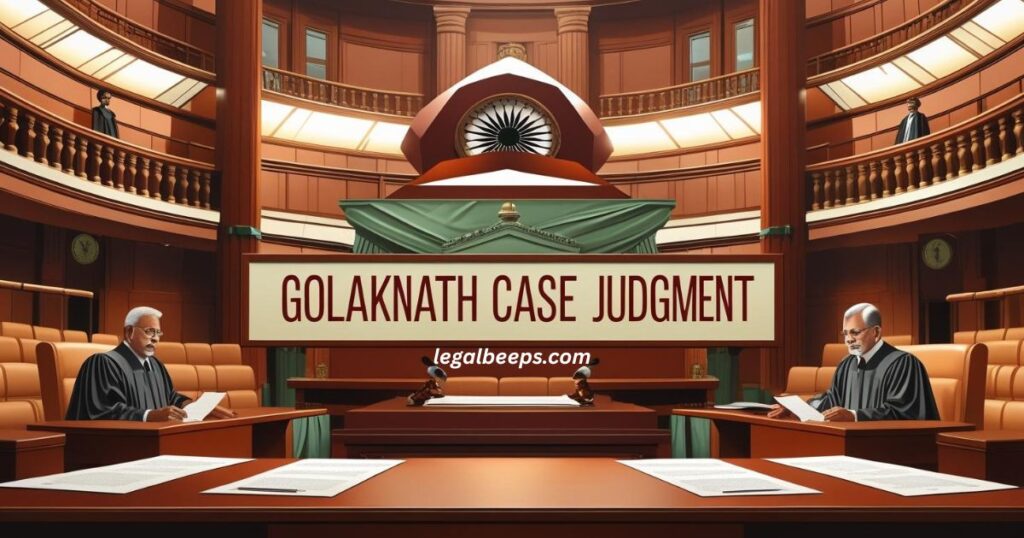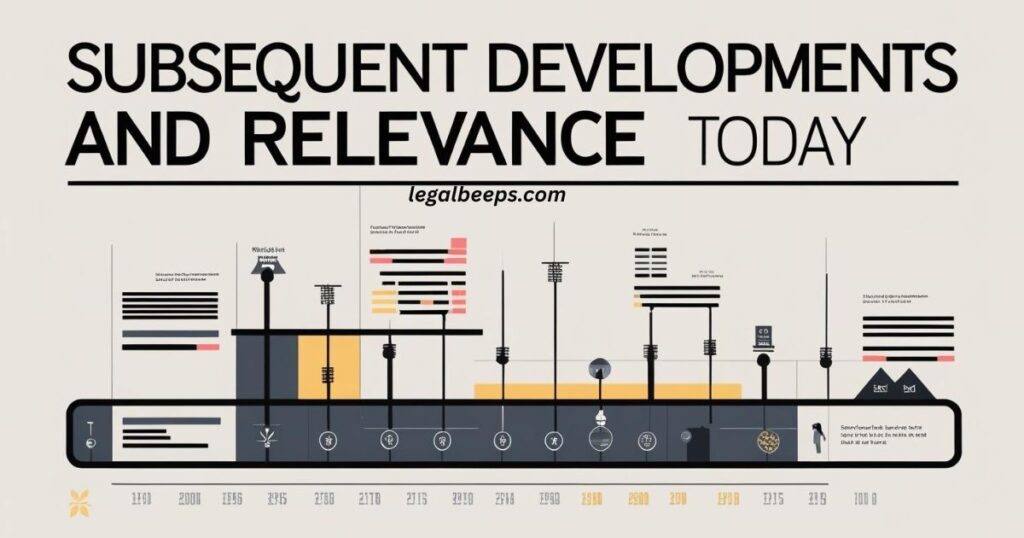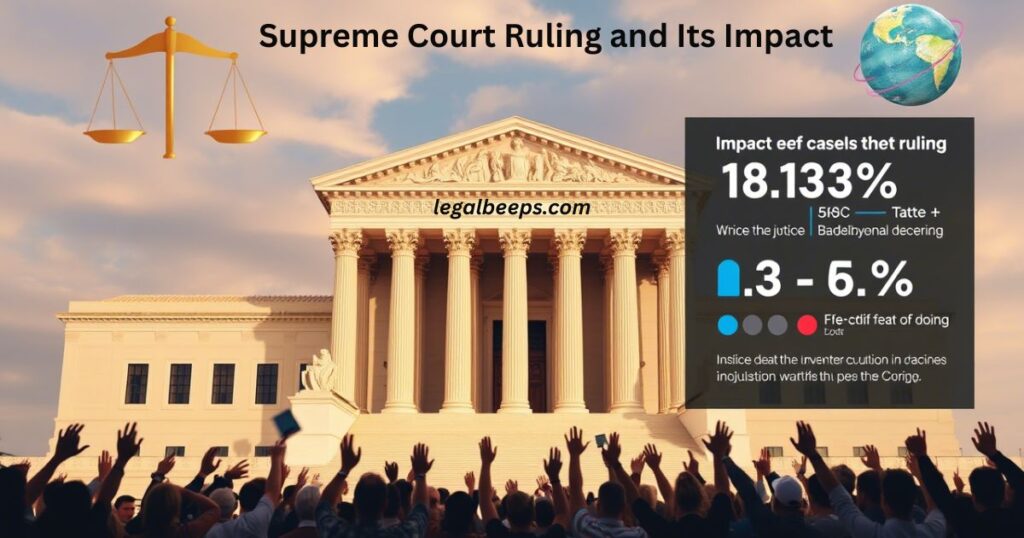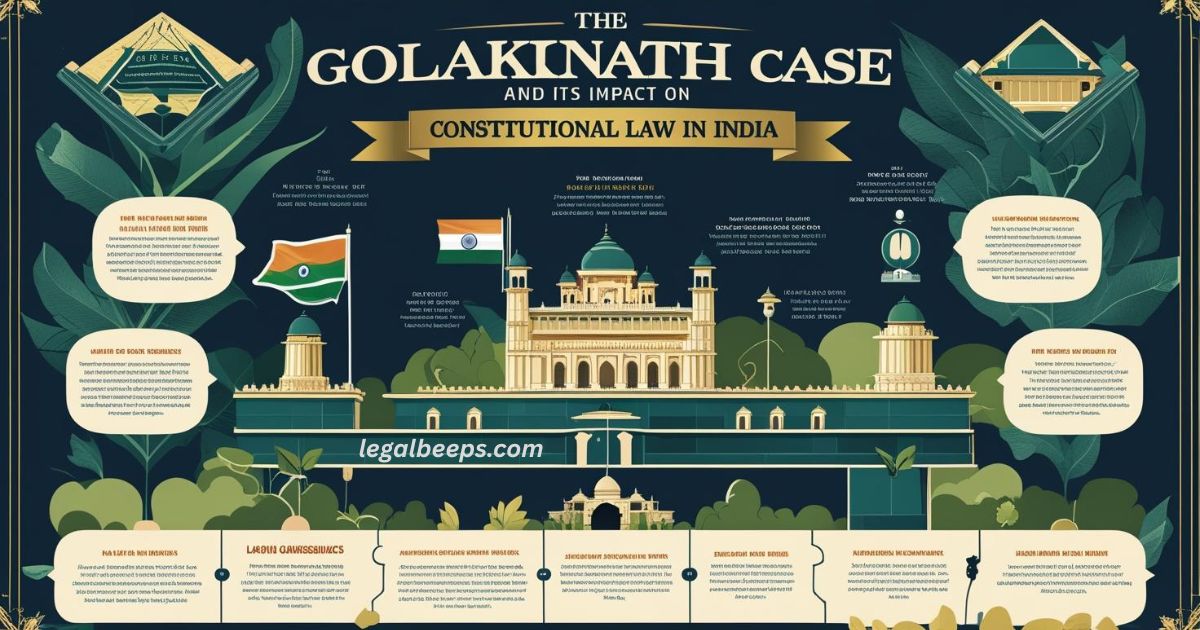The Golaknath Case was a turning point in Indian legal history. It changed how we see the Constitution and the power to amend it. This Case made sure that fundamental rights are protected. It said that the Parliament of India cannot take away these rights. This case became a strong base for later cases like the Kesavananda Bharati case. The Supreme Court of India gave this judgment in 1967.
The Golaknath Case and Its Impact on Constitutional Law in India is huge. It added strength to the rule of law and judicial independence. It helped shape constitutional interpretation in India. This case also raised questions about Article 368, judicial review, and the Basic Structure doctrine. It’s linked to topics like 406 IPC in Hindi, 352 BNS in Hindi, धारा 506 क्या है, and 302 Dhara kya hai.
Background and Context of the Golaknath Case
The Golaknath Case is a key part of India’s legal history. It was heard by the Supreme Court of India in 1967. The case came from a fight over property rights. The Golaknath family owned land in Punjab. They were affected by land reform laws made by the Parliament of India. These laws took away some of their land. The family said this went against their fundamental rights under Part III of the Constitution.
This Case and Its Impact on Constitutional Law in India was huge. It changed how we view the amending power of Parliament. The court said that fundamental rights cannot be taken away by constitutional amendments. This led to major debates on judicial review, the Basic Structure doctrine, and Article 368. The case became a must-study for anyone learning Indian constitutional law.
Key Issues Addressed in the Golaknath Case
This Case and Its Impact on Constitutional Law in India brought up some major questions about power, rights, and democracy. The case asked if Parliament of India could change any part of the Constitution, even those that protect fundamental rights. Here are the key issues that were discussed during the case:
- Parliament’s Power to Amend Fundamental Rights
The main issue was whether Parliament could change parts of the Constitution that protect fundamental rights. - Protection of Citizen Liberties
Petitioners said rights like freedom of speech and property cannot be touched, even by constitutional amendments. - Limits of Article 368
The case questioned if Article 368 gave unlimited power to change any part of the Constitution. - Judiciary vs. Parliament
It raised the issue of whether the judiciary could stop Parliament from making laws that hurt citizen freedoms. - Balance of Power
The case looked at how to keep power balanced between the Supreme Court of India and Parliament of India. - Basic Structure of the Constitution
Though not named yet, the idea that some parts of the Constitution must remain unchanged was introduced here. - Impact on Judicial Review
The court showed how it could use judicial review to block harmful laws made by Parliament. - Constitutional Amendments vs. Original Intent
It debated if new amendments could ignore the foundational principles set by the Constitution’s framers. - Preventing Legislative Overreach
The case was a warning against too much power being taken by lawmakers over people’s rights and freedoms. - Rise of Constitutional Guardianship
It showed the Supreme Court’s role as the guardian of the Constitution and protector of fundamental rights.
Arguments Presented by the Petitioners
The petitioners in this Case argued that Parliament must not have the power to amend fundamental rights. They believed that these rights are permanent and form the core of the Constitution. Any attempt to change them would destroy democratic values. Their argument focused on protecting citizen freedoms.
They also said the power to amend under Article 368 should not include the power to take away rights in Part III of the Constitution. According to them, this Case and Its Impact on Constitutional Law in India must safeguard human rights and keep power limited. The petitioners warned that allowing amendments would weaken the rule of law and harm India’s democratic framework.
Arguments Presented by the Respondents
The respondents in this Case argued that Parliament of India has full power to amend the Constitution. They believed Article 368 gave Parliament the right to change any part, including fundamental rights, to meet public needs. Their view supported Parliamentary sovereignty over individual liberty during social reform.
They claimed this Case and Its Impact on Constitutional Law in India should reflect the will of the people through their elected representatives. According to them, stopping amendments would block progress in areas like redistribution of resources and social justice. They defended changes for the sake of public interest and economic equality.
Judgment of the Supreme Court in the Golaknath Case

In this Case, the Supreme Court of India ruled that Parliament cannot amend fundamental rights. The majority held that these rights are beyond the reach of Article 368. The judgment emphasized protecting personal liberty and marked a shift in constitutional interpretation and the court’s role in judicial review.
The ruling in this Case and Its Impact on Constitutional Law in India was historic. It limited the amending power of Parliament and upheld the sacrosanct nature of fundamental rights. This decision became a stepping stone for the Basic Structure doctrine and helped preserve the constitutional integrity of the Indian Republic.
Significance of the ‘Basic Structure’ Doctrine
The Basic Structure doctrine has been a cornerstone in the interpretation of the Indian Constitution. It provides vital protection to the principles that define the democratic framework of the nation. By limiting certain powers, it ensures the integrity of India’s constitutional framework remains intact and safeguarded.
- Protection of Core Values
The doctrine ensures that Parliament cannot amend the Constitution in a way that damages the core values of democracy and individual rights. - Guarding Fundamental Rights
It protects fundamental rights by preventing changes that could reduce citizens’ liberties, preserving them as the heart of the Indian Constitution. - Judiciary’s Role as Guardian
The doctrine reinforces the Supreme Court’s power to oversee amendments, ensuring they do not harm the democratic framework or essential principles. - Balance of Power
It helps maintain balance between the judiciary, executive, and legislature, stopping one branch from taking too much power and undermining the Constitution. - Limitations on Parliamentary Power
The doctrine stops Parliament from exercising unchecked power by ensuring it cannot change the basic structure of the Indian Constitution. - Safeguarding Constitutional Integrity
The doctrine guarantees that any change respects the fundamental principles of the Constitution, maintaining the integrity of India’s democratic system. - Flexibility with Restrictions
While allowing for necessary amendments, it restricts changes that would disrupt the foundation of the Constitution, ensuring reforms do not harm core principles. - Prevention of Authoritarianism
By protecting the basic structure, the doctrine helps prevent any shift toward authoritarian rule, maintaining long-term stability in India’s political system. - Support for Judicial Review
The doctrine strengthens the judicial review process, allowing courts to evaluate if amendments violate the Constitution’s fundamental principles. - Evolving with Society
While preserving constitutional integrity, the doctrine allows for flexibility, ensuring that India’s Constitution evolves with changing social and political contexts.
The Basic Structure Doctrine plays a crucial role in maintaining the democratic ethos and safeguarding individual rights. Its significance goes beyond just legal frameworks; it protects the integrity and essence of India’s Constitution. It ensures that amendments do not alter the foundational principles that keep the country’s democracy intact.
Subsequent Developments and Relevance Today

This case had a profound impact on India’s constitutional landscape, setting the stage for the development of the Basic Structure doctrine. This case shifted the balance of power, emphasizing the need to safeguard fundamental rights and ensuring that no constitutional amendments could alter the core principles of the Constitution. Below is a table outlining the subsequent developments and the current relevance of the Golaknath case in constitutional law.
| Aspect | Details |
| Evolution of Constitutional Landscape | This case laid the foundation for the Basic Structure doctrine. This doctrine was further developed in the Kesavananda Bharati case (1973), which restricted Parliament’s power to amend core constitutional principles. |
| Judicial Assertiveness | The Golaknath ruling represented a significant shift towards a more assertive judiciary. It showed the courts’ willingness to limit Parliament’s ability to amend the Constitution, a stance reaffirmed in the Kesavananda Bharati case. |
| Basic Structure Doctrine | The Basic Structure doctrine, articulated in Kesavananda Bharati, has been central in striking down amendments that violate the Constitution’s fundamental principles. It was referenced in Minerva Mills (1980) and Indira Gandhi Election case (1975). |
| Relevance of this Case | This case remains a defining moment in India’s constitutional history. It marked the judiciary’s commitment to protecting fundamental rights from legislative overreach and is often cited in legal discussions on constitutional amendments. |
| Contemporary Significance | The principles established in this case continue to shape constitutional law in India. They serve as a reminder of the importance of protecting fundamental rights and maintaining the balance of power between the judiciary and Parliament. |
| Role of Judiciary | This case emphasizes the judiciary’s role in protecting the Constitution. It ensures the Constitution evolves with society while adhering to core democratic principles. This reinforces the judiciary’s duty as the guardian of the Constitution. |
| Limitations on Parliamentary Power | Thiscase placed limits on Parliament’s ability to amend fundamental rights. This ruling prevents the legislature from altering the core structure of the Indian Constitution, thus preserving the democratic framework. |
| Impact on Legal Precedents | This case became a cornerstone for legal precedents concerning constitutional amendments. It is frequently referenced in subsequent rulings related to Parliament’s power and judicial oversight of constitutional changes. |
| Judicial Review in Amendments | The case highlights the importance of judicial review in overseeing amendments that may undermine fundamental rights. It ensures that any changes made by Parliament do not infringe upon the basic structure of the Constitution. |
| Future Implications | This case continues to influence the future of constitutional amendments. It serves as a guide for balancing the amending power of Parliament with the need to protect core constitutional values. |
Origin and Trigger of the Golaknath Case
This Case started when the Golaknath family challenged Parliament’s attempt to take their land. They believed that the right to property was a fundamental right under Part III of the Constitution. This triggered one of the most debated legal battles in Indian constitutional history.
This Case and Its Impact on Constitutional Law in India began with concerns about Parliament’s growing power to amend the Constitution. Citizens feared their rights could be changed anytime. This fear sparked a legal challenge that questioned how far Parliament could go, especially regarding rights that were seen as untouchable.
Key Constitutional Issues in the Golaknath Verdict
The main issue in this Case was whether Parliament could change any part of the Constitution, including fundamental rights. Article 368 was central to the case. The Supreme Court had to decide if the power to amend was unlimited or had legal boundaries.
This Case and Its Impact on Constitutional Law in India raised questions about balance. Could elected leaders limit citizen freedoms for the sake of new laws? This case forced the Court to protect individual rights while respecting democratic law-making. The judgment became a turning point in the Indian legal system.
Also Read: Legal Remedies for Breach of Contract
Petitioners’ Stand in the Golaknath Case
In this Case, the petitioners argued that fundamental rights are sacred and beyond Parliament’s reach. They believed Parliament cannot amend or take away these rights. They asked the Court to stop any such amendment under Article 368 to protect citizen liberties.
This Case and Its Impact on Constitutional Law in India focused heavily on the framers’ original intent. The petitioners insisted the Constitution was meant to limit power, not allow Parliament to rewrite it at will. They stressed that rights such as equality and property must remain untouched, no matter the political agenda.
Supreme Court Ruling and Its Impact

The Supreme Court ruled in favor of the petitioners in this Case. It held that Parliament cannot amend fundamental rights. This was a bold judgment, as it limited Parliament’s power under Article 368 for the first time. The ruling marked a shift in constitutional interpretation.
This Case and Its Impact on Constitutional Law in India was huge. It led to intense legal debates and future cases like Kesavananda Bharati. The decision introduced a new era of judicial review. It made the judiciary the final guardian of rights and changed how India viewed constitutional amendments forever.
FAQ’s
What is the Golaknath Case?
This Case was a landmark ruling that limited Parliament’s power to amend the Constitution, especially in relation to fundamental rights. It significantly impacted India’s constitutional law.
How did the Golaknath Case impact constitutional law in India?
This Case and Its Impact on Constitutional Law in India established the Basic Structure doctrine, restricting Parliament from altering fundamental rights and the Constitution’s core principles.
What was the key issue in the Golaknath Case?
The key issue in this Case was whether Parliament could amend the Constitution, particularly provisions related to fundamental rights, under Article 368 of the Constitution.
What doctrine emerged from the Golaknath Case?
The Basic Structure doctrine emerged from this Case, limiting Parliament’s ability to amend any part of the Constitution that alters its fundamental structure.
Why is the Golaknath Case important?
This Case is important because it ensured that fundamental rights cannot be altered by Parliament through amendments, and it established judicial oversight over constitutional changes.
Conclusion
The Golaknath Case was a major moment in India’s legal history. It said Parliament cannot change fundamental rights using Article 368. This case made it clear that our rights are permanent and must not be taken away by laws or amendments. This Case gave more power to the Supreme Court of India to stop any changes that harm basic rights.
The Golaknath Case also led to the birth of the Basic Structure doctrine in later cases. This idea protects the heart of the Constitution. It keeps India’s constitutional framework strong and fair. The Golaknath Case and Its Impact on Constitutional Law in India still matter today. It reminds lawmakers to respect constitutional principles. It ensures that individual liberties and democracy stay safe for all citizens. That is why this Case must always be remembered.

